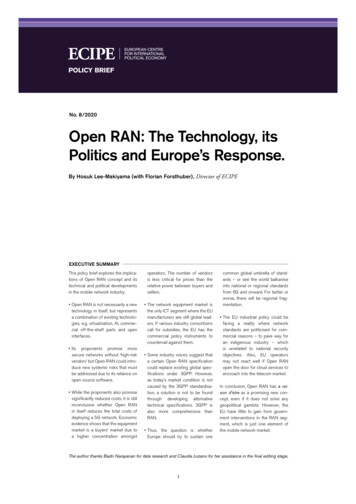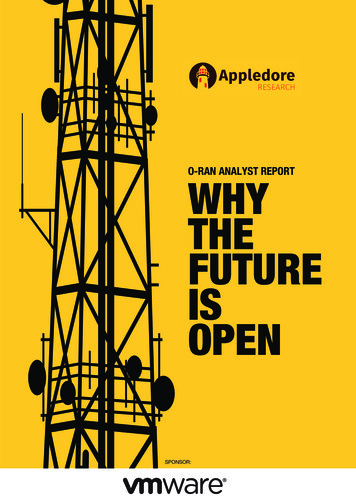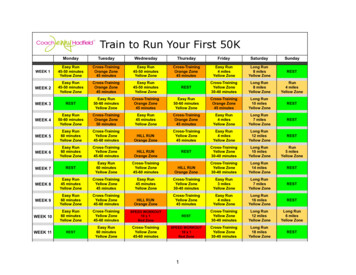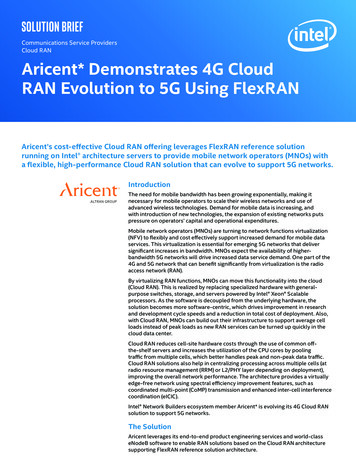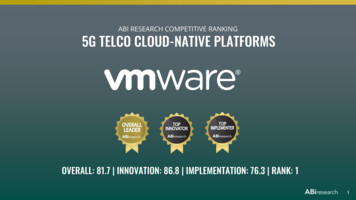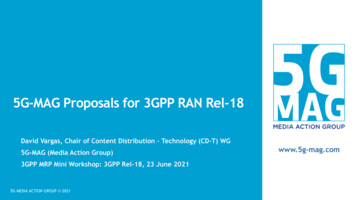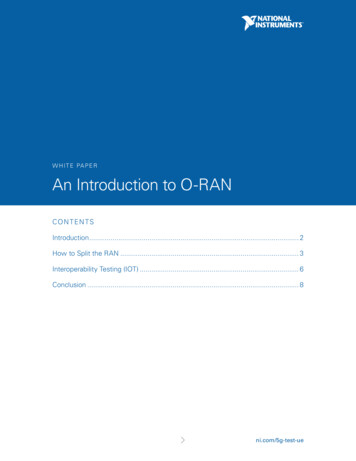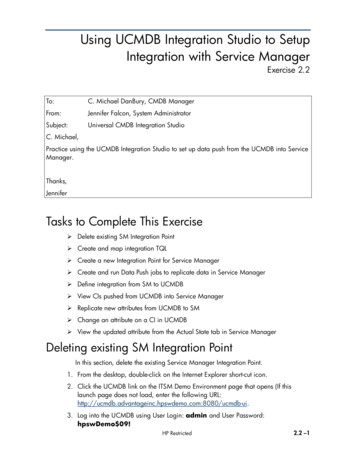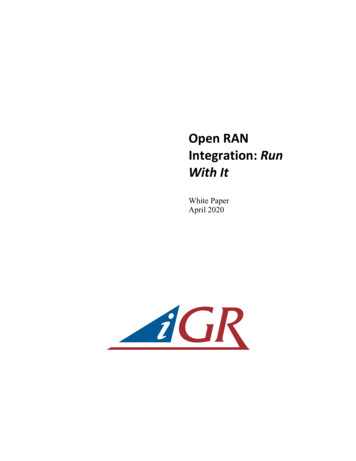
Transcription
Open RANIntegration: RunWith ItWhite PaperApril 2020
Table of ContentsEXECUTIVE SUMMARY1WHAT IS OPEN RAN?4The Open RAN ecosystemFigure 2: O-RAN Alliance Architecture55Virtualization and openness6Open RAN componentsFigure 3: 4G RAN and the CU-DU Split in the 5G RAN68Industry challenges that drive Open RAN9Benefits of Open RAN9Figure 1: Open RAN commercial deployments2OPEN RAN INTEGRATION11OPEN RAN CASE STUDIES15Vodafone16Rakuten17IpT18MTN18Open Test and Integration Center18VENDOR PROFILES20Altiostar20Mavenir20Parallel Wireless20ABOUT IGR22Disclaimer22Table 1: Easy to Counter – the arguments against Open RAN integrationCopyright 2020 iGillottResearch Inc.11
Executive SummaryThe Open RAN concept and movement is not new – mobile operators andnetwork and technology vendors have been developing solutions, conductingtrials and deploying networks for the last few years. The important point is thatOpen RAN networks are being deployed today by major operators around theworld – this is no longer a science experiment.The Open RAN concept is about disaggregating the RAN functionality by buildingnetworks using a fully programmable software-defined mobile network solutionbased on open interfaces – radios, base stations, etc. – that runs on commercial,off-the-shelf hardware (COTS) with open interfaces.There are two main organizations driving Open RAN:§OpenRAN refers to the project group that is a part of the Telecom InfraGroup (TIP) whose main objective is the deployment of fullyprogrammable RAN solutions based on GPPP/COTS and disaggregatedsoftware.§The O-RAN Alliance is the other main driver of the Open RAN concept,focused on efforts to standardize interfaces. The alliance was founded in2018 by AT&T, China Mobile, Deutsche Telekom, NTT DOCOMO andOrange.A recent important step in the development of the Open RAN ecosystem was analliance agreement between the two organizations. The new agreement allowsthe two groups to share information, reference specifications and conduct jointtesting and integration efforts.Open RAN software and hardware vendors have been developing networksolutions for the last few years. As part of the research for this paper, iGRidentified 22 publicly announced MNOs around the world using equipment frommultiple vendors, including Altiostar, Mavenir and Parallel Wireless, who haddeployed Open RAN in commercial networks. These MNOs have collectively justover 1.199 billion subscribers in their commercial networks and operate incountries or regions with a total population of more than 2.4 billion.This means that these operators are responsible for 21.8 percent of the world’smobile subscriber base. Furthermore, assuming the current trials convert tocommercial deployments, iGR estimates that by 2024, Open RAN will be used byMNOs that collectively are responsible for 47.2 percent of the global subscriberbase.As a visual example of how widespread Open RAN is becoming, consider thefollowing map: this shows the Open RAN announced commercial networkdeployments around the world, from the research iGR conducted in preparingthis white paper.1Copyright 2020 iGillottResearch Inc.
Figure 1: Open RAN commercial deploymentsSource: iGR; company reports; 2020Clearly, Open RAN is no longer a regional solution, nor one that only applies togreenfield operators or MNOs in developing regions of the world. Open RAN hasbeen deployed to support legacy 2G and 3G network technologies, as well as 4GLTE and 5G. It has been deployed in the most developed and competitive marketsin the world, supporting some of the fastest growing regions.These MNOs have realized significant savings in CapEx and OpEx and many havediscussed this publicly. The benefits of deploying Open RAN are real. Consider:§Accenture stated that 5G deployments that used COTS hardware andOpen RAN software had seen CapEx savings of 49 percent compared totraditional deployment options.§Senza Fili estimated the savings for a cloud RAN deployment to be 37percent over five years, compared to a DRAN deployment. Specifically,the study showed a 49 percent savings in CapEx in year one and acumulative 31 percent savings in OpEx over the five years.§Strategy Analytics modelled the TCO of Open RAN over a five-year period.This model showed 40 percent lower CapEx and 34 percent lower OpExcompared to a legacy RAN.Vodafone shared network performance information from its OpenRANdeployment in Turkey. Vodafone stated that the network has achieved 96 KPIs inboth 2G and 4G networks; achieved QoS levels that are already acceptable (as ofOctober 2019); and that, as of October 2019, that network optimization was2Copyright 2020 iGillottResearch Inc.
ongoing, and they expected to achieve all of the target KPIs soon. And in April2020, Vodafone Idea announced that OpenRAN has been deployed on multiplecell sites and has been carrying commercial traffic since December 2019.Rakuten is considered to be a text book example of how Open RAN can supporta nationwide mobile operator. In 2019, the Japanese carrier was the first toimplement a multi-vendor RAN, using products from Altiostar, Airspan, Mavenir,Nokia and others. Nokia opened up their radio interfaces to Altiostar’s BBU whichwas running on a Cisco virtualization platform. Other functions within thenetwork were also multi-vendor such as the EPC from Cisco, and IMS and RCSapplications from Mavenir. Rakuten’s network began as an LTE networkconsisting of both macro and small cells. The company has said it will evolve itsnetwork to 5G NR in 2020.In April 2020, just as the research was being finalized, Dish Network announcedthe first vendor selection (Mavenir) for its 5G Open RAN nationwide networkdeployment, using spectrum Dish has acquired over the last few years.This shows how cloud, virtualization, openness and vRAN architectures andpractices can be applied to a new network deployment. With Rakuten, a legacyvendor opened their interfaces to support Open RAN radios and baseband unitsfrom other vendors. Rakuten’s CTO Tareq Amin has said the Open RANframework has proved approximately 40 percent less expensive than traditionaltelecommunications infrastructure (Source: Light Reading; SDX Central, 2020).According to press reports, Rakuten deployed lean cell sites, with only antennaand remote radio heads, easing site acquisition and reducing deployment costs,and uses virtual RAN (vRAN) for baseband processing.The takeaway here is that Open RAN is real; Open RAN can be, and is being,deployed in commercial networks today; the Open RAN community is coalescingand coordinating to move deployments along; the cost savings are being realized;and operational performance requirements and KPIs are being met.3Copyright 2020 iGillottResearch Inc.
What is Open RAN?Fundamentally, the Open RAN concept is about building networks using a fullyprogrammable software-defined radio access network solution based on openinterfaces – radios, base stations, etc. – that runs on commercial, off-the-shelfhardware (COTS) with open interfaces. Traditionally, mobile networks have beenbuilt with closed, proprietary software and purpose-built hardware. But today,mobile networks can be disaggregated and based on the Open RAN concept.In this context, disaggregation means separating the hardware from the software.The 3GPP introduced this concept in Release 14 of its specification with theControl and User Plane Separation (CUPS) of evolved packet core (EPC) nodes andthe O-RAN Alliance produced the Open RAN specifications. With 5G New Radio(NR) in 3GPP Release 15 and beyond, this split is continued with the Service BasedArchitecture (SBA). 5G NR further abets disaggregation by continuing the splitbetween control and user plane all the way down into the 5G base stations andradios with the central unit and distributed unit.The main reasons to move away from the old, vertically integrated model to theOpen RAN concept are those that drive virtualization of data centers andenterprise networks and the disaggregation of hardware and software:§Take better advantage of the rapid advances in computing power deliveredby Moore’s Law. The data center industry experienced a similar disruptionback in the 2000s.§Use software components to not only implement core network, radio andbase station functionality, but also introduce new capabilities as they aredeveloped.§Use best of breed components and software in architecting building theinfrastructure for the network.§Reduce capital and operational/maintenance expenses since there iscompetition among many different layers of the hardware and softwaresupply chain. Operation and maintenance of an Open RAN system issimplified because the hardware is standardized, standardized interoperableinterfaces and open APIs are used, DevOps approaches can be utilized, andthe software does not rely on purpose-built components.§Enabling edge centric architecture – multiple mini data centers can be builtcloser to subscribers, especially in high population areas, to serve subscriberneeds, support low latency connectivity for 5G applications and providescalability for both devices and applications.§Expand the supply chain for RAN solutions, thereby diversifying theecosystem of vendors from which MNOs can procure network equipment.4Copyright 2020 iGillottResearch Inc.
The Open RAN ecosystemThere are two main organizations driving Open RAN movement:§OpenRAN refers to the project group that is a part of the Telecom InfraGroup (TIP). The main objective is the deployment of fully programmableRAN solutions based on GPPP/COTS and disaggregated software so thatoperators and vendors can benefit from the flexibility and faster pace ofinnovation capable with software-driven development.§The O-RAN Alliance is the other main driver of the OpenRAN concept,especially the efforts to standardize interfaces, in addition to the TIP.Founded in 2018 by AT&T, China Mobile, Deutsche Telekom, NTTDOCOMO and Orange, the O-RAN Alliance’s goal is to foster thedevelopment of reference designs and standards such that current andfuture RANs can be built with “virtualized network elements, white-boxhardware and standardized interfaces that fully embrace O-RAN’s coreprinciples of intelligence and openness.” (Note: The O-RAN Alliance wascreated by merging the C-RAN Alliance and the xRAN Forum.)The following graphic summarizes the components of the O-RAN Alliance’sreference architecture.Figure 2: O-RAN Alliance ArchitectureSource: O-RAN Alliance, 20195Copyright 2020 iGillottResearch Inc.
A recent important step in the development of the Open RAN ecosystem was analliance agreement between the two organizations to ensure they were inalignment in developing interoperable, disaggregated and Open RAN solutions.The new agreement allows the two groups to share information, referencespecifications and conduct joint testing and integration efforts.Inherent in Open RAN is support for existing radio access networks in addition to5G Nonstandalone (NSA) and Standalone (SA) networks. There are many parts ofthe world where all of these various technology generations must be supported;Open RAN actually allows that to happen on the same infrastructure.To achieve this goal, the Open RAN movement helps enable a broader and vibrantopen ecosystem of complete solutions and solution components that takeadvantage of the latest capabilities of GPPs, both at a software level and alsousing readily available programmable offload mechanisms such as fieldprogrammable gate arrays (FPGA), and open interfaces.Virtualization and opennessIt is important to understand that virtualization and openness are not the samething. Virtualization is disaggregation of hardware and software by abstractingthe software application from the underlying hardware. A RAN can be virtualizedbut not be open – i.e., the software and/or the hardware could be proprietary, orthe interfaces could be closed.Being truly “open” means that there are reference designs and standards forhardware and software such that there are open interfaces with no proprietaryinterfaces and/or hardware in the RAN. For example, a COTS remote radiohead/unit (RRH/U) from Vendor A will be able to talk via open interfaces to(proprietary) software running on a COTS server with (virtualized) networkfunctions from Vendor B.Note that openness does not mean that all hardware and software will be theidentical for all mobile networks. Vendors will compete to produce all of thehardware and software such that operators will have a broad selection in termsof scale, scope, features and cost. Due to the open interfaces and standardizedhardware, the network software will run on COTS and talk to hardware andsoftware from other vendors. This will lead to a wider procurement ecosystemfrom different vendors.Open RAN componentsThe goal of this paper is not to describe in detail the technologies involved inOpen RAN – the various technologies and architectures are complex and difficultto cover in a short white paper. There is a range of network architectures thatare needed to address the specific needs of different mobile operators aroundthe world and it is expected that vendors will interoperate to create customizedsolutions to meet these requirements.6Copyright 2020 iGillottResearch Inc.
Moving forward into the world of 5G NR which, in 3GPP terms are Release 15 andbeyond, the specifications require the RAN to become a new, disaggregatedgrouping of functional elements (as has been discussed earlier in this paper). The5G base station, known as the gNB (as opposed to the eNodeB or eNB in LTE), iscomprised of several functional units:§The radio unit (RU) which comprises the RF chain, to transmit or receive theover-the-air signal and provide corresponding transformation of the analogradio signal and the digital signals.§The distributed unit (DU) which handles the lower layers of the basebandprocessing up through the PDCP layer of the protocol stack. In legacy systems,this runs on a proprietary hardware appliance, but today’s software (whichruns on COTS) allows this function to be virtualized. Since it is virtualized, thisgives flexibility in terms of placing the processes at different locations whichmay include the cell site, far edge locations and/or the centralized locations.These functional splits are defined in the 3GPP specifications and theirplacement is selected based on type of transport available to the cell sites.§The centralized unit (CU) handles all higher layer functions of the protocolstack from PDCP and above.As has been stated, the goal of Open RAN is to create open interfaces so that thehardware and software from different vendors can interoperate and talk to eachother. One key initiative is the TIP Evenstar program which has developed aRemote Radio Head (RRH) that will be available in the second half of 2020. TheEvenstar RRH decouples the base components of the RRH and will support the ORAN Central Unit-Distributed Unit (CU-DU) architectural split known as 7.2.Beyond this, other vendors including MTI, Gigatera Communications, NEC,Airspan and Fujitsu have announced that they plan to provide radios in variousconfigurations which will adhere to Open RAN specifications.The following graphic shows the 4G RAN and core network as compared to the5G RAN and core.7Copyright 2020 iGillottResearch Inc.
Figure 3: 4G RAN and the CU-DU Split in the 5G RANSource: Transport network support of IMT-2020/5G, ITU-T Report, February 2018Note that in 5G, the BBU function from LTE is split between the CU and DU andthis depends on which path the mobile operator is taking toward 5G, as there aremany options that accommodate incumbent 2G, 3G and 4G networks, as well asthe level of integration between the current network and a new 5G network.The 3GPP defined multiple deployment options for carriers that are migrating to5G NR from LTE. Two of the most likely paths are:§Option 1 to Option 3x to Option 7x to Option 4a to Option 2: This pathassumed that the operator already has an extensive RAN and a core network(EPC) that it wants to leverage before introducing a 5G core. The currentroadmap assumes that Option 3 is already deployed, that Option 2 will bedeployed when ready, and that the two configurations will coexist for sometime. This path involves using multiple radio access technologies.§Option 1 to Option 3x to Option 4a to Option 2: This path also assumes theexistence of a RAN and core, but the move directly to 4a implies that 5G RANcoverage gets built out, the 5G core introduced and then the operator movesdirectly to 4a or Option 2.It is iGR’s understanding that the main differences between these two routesinvolve the extent of the changes and how long the process takes. These optionsenable operators to leverage the existing EPC that they have in their networksand allow for a migration path towards 5GC. It appears that both Option 3 and8Copyright 2020 iGillottResearch Inc.
Option 7, regardless of the sub-type, are interim steps and the amount of timethe operator spends in either option will depend on many external and internalvariables.And consider that regardless of how quickly mobile operators might want tomove in the migration, they will likely be required to support multiple radioaccess technologies (RATs) for at least 10 years if not longer due to market andregulatory demands. Thus, the ability to support incumbent networktechnologies cost-effectively becomes even more important.Industry challenges that drive Open RANThe legacy RAN vendors have provided solutions that are proprietary and siloedfor each air interface generation. By virtue of their established base of traditionalmobile operator radio infrastructure, these vendors may position themselves toprovide some of the benefits associated with virtualization and they may complywith the 3GPP release specifications, but they are not required to open up theirhardware/software interfaces to other equipment vendors.Therefore, they continue to promote and provide only closed, proprietarysystems that are only in their best interests and not creating a future-proofnetwork for their operator customers, although it is completely within theircapabilities today. In some cases, the legacy OEM’s reluctant decision to open upany part of their hardware/software architectures has been driven by therequirements of some of their incumbent mobile operator customers.In part, one of the drivers for Open RAN has been the need to expand the radioecosystem – the reality is that there are relatively few radio vendors availabletoday. The radio is one of the most important components in a mobile network,it provides the link between the subscriber and the network and is thereforewidely deployed. Growing the radio ecosystem is therefore seen as important forthe success of the Open RAN movement.Deploying and maintaining/optimizing traditional networks requires a lot ofmanual labor and results in high cost. This can be addressed with theautomation/DevOps approach in Open RAN solutions. DevOps has been definedas the practice of development and operations and engineers (hence DevOps)working together from the service design all the way through the developmentprocess to production support. And by introducing ContinuousIntegration/Continuous Development (CI/CD) models from the cloud domains ofthe IT industry, operational costs can be reduced significantly, and new featurescan be rolled out faster.Benefits of Open RANFrom the mobile operator’s point of view, benefits of Open RAN include:§Lower costs – both CapEx and OpEx9Copyright 2020 iGillottResearch Inc.
§Lower deployment times – Using virtualized RAN, benefits like automationcan reduce the average time for deploying a site. And a virtualized RANcombined with centralization can be deployed faster than a traditionalarchitecture since the only site installation required is for the radio and power.The remainder of the installation uses remote software loads managedthrough central operation center which do not require an additional site visit.§Upgrade options from multiple vendors to future-proof the networkevolution. MNOs do not have to depend on the roadmap evolution of a singlevendor to roll out new features.§Minimizes the danger of vendor lock-in - the incoming Open RAN vendor’sequipment will work with the incumbent and future vendors’ solutions§Easier to scale because disaggregating hardware from software can enablecarriers to respond more quickly and in a more targeted fashion when theyneed to increase/decrease or relocate capacity§Ability to add massive scale if needed using web scale approach.The last bullet highlights one of the main architectural benefits of Open RANnetworks. Since edge computing is being deployed by mobile operators aroundthe world, the edge compute architecture can be used for Open RAN – containerscan be used to push changes (using automation) to the network, using theDevOps model. This means that the RAN is essentially following the samedevelopment curve as the data center did, with the corresponding benefits.In addition, to further support mobile operators as they transition to 5G, OpenRAN also supports legacy 2G, 3G and 4G LTE network technologies.Moving forward, the need to continue supporting LTE while also transitioning to5G adds more complexity to an already complex RAN. Not only will carriers beintroducing new frequency bands (such as mid-band/CBRS and mmWave),layering in new carrier aggregation schemes, adding small cell sites, addingcapacity to macrocells, coordinating capacity among small cell sites andmacrocells, swapping out old antennas for new, they will also need to supportedge computing solutions and new applications – VR/AR, IoT, etc.Opening up the RAN so that operators can introduce comparatively lessexpensive COTS and best-of-breed software can help operators’ future prooftheir networks and become more flexible in their operations. This modelleverages well established practices from the cloud domain in the IT world and isapplying them into the mobile telecom space.10Copyright 2020 iGillottResearch Inc.
Open RAN integrationOpen RAN is being deployed in multiple markets by multiple MNOs around theworld. They are large scale deployments in some of the largest countries in theworld.It is important to understand there are two levels of integration required whendiscussing Open RAN networks:§Open RAN ecosystem integration includes the hardware, software, systemsintegrators, data centers and MNOs. In this case, the systems integrator willbe responsible for integrating across the entire solution including integratingopen radios. To ensure the ecosystem thrives and performs as required, theSI must be impartial and not aligned or associated with a specific hardwareor software vendor.§System integration of the Open RAN software on COTS hardware. This levelof integration is similar to what occurs in the data center environment. Infact, many of the same tools and principles are used, which further easesOpen RAN adoption.§In addition to this, multiple vendors from the ecosystem can come togetherto self-integrate and certify their solutions to create a blueprint that mobileoperators can use directly into their networks.Systems integration can be provided by a variety of companies and can beprovided by one vendor if needed. This situation is similar to what the MNOs usetoday – there is no reason that Open RAN cannot be as simple and easy tointegrate and deploy as the RAN is today.Despite this activity, many of those critical of the open network movement andtrying to preserve proprietary systems still present arguments against Open RAN– these are old arguments that were leveled in the past but are no longer relevant.The following table discusses those arguments and why they no longer apply.Table 1: Easy to Counter – the arguments against Open RAN integrationOLD ARGUMENT1MNO will need tointegrate OpenRAN solutionsthemselvesDETAIL Since multiple vendors arerequired for an Open RANdeployment, solution is notintegrated MNO will therefore beresponsible for the cost ofintegrationCURRENT SITUATION Numerous Open RAN deployments in live MNOnetworks Multiple vendors have developed their Open RANsolutions specifically to be integrated ontohardware and with other software Systems Integration can be done by vendors oroperators11Copyright 2020 iGillottResearch Inc.
OLD ARGUMENTDETAIL This will lead to higheroverall costs and delayedtime to marketCURRENT SITUATION Hardware and software vendors have followeddata center integration best practices which arewell established in the IT world MNOs that have deployed Open RAN have saidintegration costs are no higher than with thetraditional single-vendor approach Note that traditional approach to deploying RANalso requires integration between differentvendors – for example, for OSS/BSS, EPC and RANand there are associated service agreements witheach vendor2High risk fornetworkreliability Since network elements arefrom different vendors,network reliability will becompromised Identifying network issueswill be more complex due tothe solution using multiplevendor software andhardware Since network elements arefrom multiple vendors, theoverall networkperformance will becompromised3Lower overallnetworkperformance Disparate network elementscannot be integrated tomaximize performance Open RAN network deployments havedemonstrated ability to support large subscriberbases and meet network performance KPIs Network management tools have been developedfor Open RAN, meaning that any issues can bequickly identified and resolved Modularity will help operators audit anddetermine problems with their network faster. Real world Open RAN network deployments havedemonstrated ability to support large subscriberbases and meet network performance KPIs. Vodafone shared KPIs from its Open RANdeployment in Turkey that are comparable to KPIsfrom the legacy vendors Software-based RAN allows for more rapiddeployment of upgraded features, therebyallowing the operator fine tune performancefeatures for their network and roll out advancednew features like carrier-aggregation to boostperformance. DevOps approach with CD/CI can push updatesquickly to many different sites, all automated andorchestrated4Lower CapExsolution costsavings notrealized Use of disparate RANvendors results in higherinitial costs, since overallvolumes are lower than Actual Open RAN network deployments bymultiple MNOs have resulted in significantly lowercosts – both CapEx and OpEx (40 percentaccording to Rakuten)12Copyright 2020 iGillottResearch Inc.
OLD ARGUMENTDETAILfrom using a single RANvendorCURRENT SITUATION Numerous TCO studies also prove and supportsimilar CapEx and OpEx savings (up to 40 percent) COTS hardware is generally lower cost, due tomassive scale spread across enterprise IT, datacenter industries etc Software can be developed and scaled quickly andat lower cost using modern tools and practicessuch as DevOps, etc leading to lower operationalcosts.567Overall costshigher thantraditionalSystemsintegrationlackingLess secure Even allowing for a lowersoftware-based RANsolution on COTS, argumentis that the overalldeployment cost (includingintegration) will be higher Actual Open RAN network deployments bymultiple MNOs have resulted in significantly lowercosts – both CapEx and OpEx (40% Rakuten) Open RAN solutions havenot been integrated Multiple MNO deployments show that differentsoftware components have been integrated Argument is that softwaresolutions are not integrated,and that software is notintegrated onto hardware Rich ecosystem of vendors for radios, basebandhardware and software are already workingtogether to ensure integrated solutions areavailable to the market Lack of integration,argument is that Open RANdeployments are inherentlyless secure than thetraditional single-vendorapproach Open RAN deployments have followed datacenter, private cloud, and enterprise IT integrationand security best practices Some MNOs have stated that Open RANintegration costs have actually been lower thanfor the traditional approach More auditable interfaces for an MNO to takecontrol of their own security versus a black boxapproach by traditional vendors Security is a joint responsibility across the vendorsand the MNO versus a single vendor8Ecosystem notdeveloped tosupport MNOs Since Open RAN is so newand untested, there is nodeveloped ecosystem ofvendors to support thenational MNO Therefore, the MNO will beresponsible for manyinstallation, maintenance Open RAN now supported and deployed by someof the largest hardware and software vendors inthe world. For example, Rakuten is using an IMSfrom Mavenir, and Open RAN architecture fromCisco, Altiostar and Nokia to create an E2E cloudarchitecture. IpT and Vodafone deployments alsoutilize components from different vendors13Copyright 2020 iGillottResearch Inc.
OLD ARGUMENTDETAILand operational tasksthemselvesCURRENT SITUATION Also, now a wide range of specialist RAN softwarevendors developing and deploying solutions Multiple vendors in the ecosystem who arecoming together to create blueprints that willensure the solutions are not only available butwell tested. Many companies in the ecosystem such as Intel,Cisco, Fujitsu, MTI, VMware, Qualcomm, Airspan,NEC, Dell, Red Hat, Quanta, GigateraCommunications, Xilinx, Sercomm, Supermicroand others have announced that are building orcontributing to Open RAN. The radio hardware ecosystem is rapidlydeveloping with TIP leading the Evenstarhardware development.9Only suited togreenfield MNOdeployments Open RAN does notintegrate well with theexisting legacy 2G and 3Gdeployments The number of actualdeployments, and thereforethe scale, is thereforelimited to greenfield MNOsonly Multiple MNO deployments show that Open RANcan support legacy technology networks as well asnew 4G LTE and 5G deployments Some of the largest MNOs are deploying OpenRAN for their running
2018 by AT&T, China Mobile, Deutsche Telekom, NTT DOCOMO and Orange. A recent important step in the development of the Open RAN ecosystem was an alliance agreement between the two organizations. The new agreement allows the two groups to share information, reference specifications and conduct joint testing and integration efforts.

